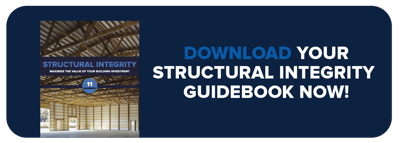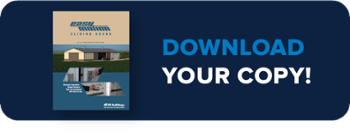Posts | Building Tips | Comparisons | Pole Barn Builders
FBi vs Greiner Buildings: Who’s Best for Your Project?
Cori grew up on her family's small grain and livestock operation in Northwest Indiana. In 2018, she graduated Summa Cum Laude with a Bachelor's degree in Business Administration & Marketing from Marian University Indianapolis. Having shown beef cattle for 12 years at the county, state, and national levels, Cori chose to pursue a career in agriculture. Today, she serves as the Marketing Content Creator on the FBi team. In her free time, Cori enjoys spending time with family and friends, watching sports, listening to live music, and traveling.
Our next builder comparison features Greiner Buildings.
They construct agricultural, commercial, and residential buildings with a commitment to “raising the standard” through superior materials and service.
In this blog, we present the facts and strengths of each post frame builder. Our goal is to provide you with a better understanding of how FBi compares to Greiner before making a buying decision.
FBi vs Greiner Buildings: 7 Key Differences to Look For
1) Customer Service
FBi Buildings
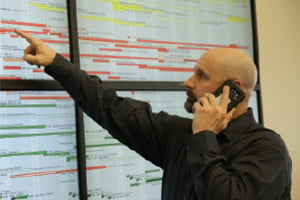
From the initial inquiry to the final call with your Project Manager (PM), FBi ensures that you’re aware of every step involved with your post-frame building.
Each customer is assigned their own Project Sales Consultant (PSC) that lives in their area.
Currently, FBi has 30+ PSCs spread throughout Indiana, Illinois, Iowa, Michigan, Missouri, and Ohio covering their designated territories.
This arrangement allows your PSC to discuss your building needs in person, walk the property, and identify an ideal location for a new pole barn.
Once the contract is finalized, and construction is ready to start, you’ll be introduced to your Project Manager. They’ll schedule crews, review building changes, handle payments, and answer questions.
FBi’s Project Management team will outline your post-frame project into four construction phases:
- Processing: An overview of your building project from the signed purchase agreement to the down payment. FBi will go over site preparation, permitting, and give you an approximate start date.
- Design and Permitting: FBi will follow up with you regarding your building permits and site prep updates. Your PM will review drawings and confirm the expected start date.
- Pre-Mobilization: Your PM will verify the site prep via inspection. If approved, the construction crews and material delivery will be scheduled.
- Construction: The final phase details the main milestones that'll happen during or after construction.
Greiner Buildings
Greiner’s customer service approach is slightly different. Instead of having an appointed PSC and PM, you’ll have one point-of-contact throughout the entire building process.
Similar to FBi, you can create your dream pole barn using their state-of-the-art 3D design tool.
From there, Greiner will provide Stamped Engineer Plans (SEPs) to the customer and contractor. These drawings are often required by the International Building Code (IBC).
Moreover, they’ll submit floor plans, request quotes, hire, and manage all subcontractors needed for your post frame project. Common trades include:
This handy service takes the load off of customers’ shoulders and provides peace of mind.
Who has the best customer service?
Both companies offer assistance every step of the way but in different capacities.
FBi has assembled a larger team (e.g., sales, design, engineering, project management, and construction crews) to handle a high volume of detailed building projects. Personalization and timeliness are essential.
While one point-of-contact may sound appealing, you may run into delays as your salesperson juggles multiple roles.
However, you cannot deny the added convenience of Greiner’s turn-key building services. It sets them apart from the competition.
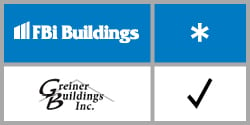
2) Service Areas

FBi Buildings
FBi is a family-owned post-frame construction company that started in 1958. Their corporate headquarters is located in Remington, Indiana. During their 60+ years, they’ve been known as the preferred post frame builder in the Midwest.
Currently, FBi Buildings’ service area includes Indiana and Illinois, with select counties in Iowa, Michigan, Ohio, and Missouri. To better serve customers in Iowa, FBi acquired Eastern Iowa Building in 2025—a company with over 20 years of post-frame experience.
If you have a unique project outside of these areas, FBi will review your request to determine if it’s feasible for them to be your pole barn builder.
Greiner Buildings
Greiner is a family-owned and operated construction company from Washington, Iowa.
In the 1980s, founder Tom Greiner worked as a subcontractor for Lester and Wick Buildings.
Since then, Greiner has expanded to a full-fledged post-frame builder serving select counties in Illinois, Iowa, and Wisconsin.
Their corporate headquarters is located in Washington (IA) with satellite offices in Des Moines (IA), Kewanee (IL), and Minonk (IL).
Who has the best service areas?
FBi easily wins this category. With 140+ counties in four different states, their coverage can’t be beaten by Greiner Buildings.
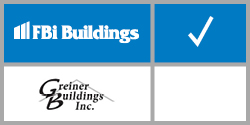
3) Pole Barn Materials
Steel
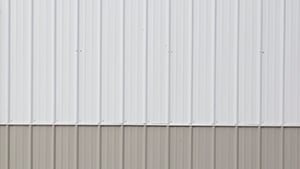 FBi Buildings
FBi Buildings
FBi’s metal panels are 29-gauge, heat-treated, full-hard, high-tensile steel with a minimum yield point of 80,000 PSI (pounds per square inch). That’s 60% to 78% higher than what’s commonly used.
A higher yield contributes to overall steel strength and improves the structural integrity of your pole barn by providing greater resistance to impact damage.
Their post frame buildings feature galvalume steel (roof and walls) coated with aluminum-zinc alloy by a continuous hot-dip process. This coating consists of 55% aluminum and 45% zinc, with a small silicon dose for fighting corrosive elements.
Depending on your pole barn colors, FBi will also use galvanized steel panels on their walls. Unlike galvalume, galvanized metal is subject to corrosion once the coating wears off.
Greiner Buildings
Greiner works with the same metal manufacturer as FBi to install 29-gauge/80,000 PSI high-tensile steel.
Who has the best steel?
Both construction companies are equal when it comes to the type of steel being used. Therefore, this section is a tie between FBi and Greiner.
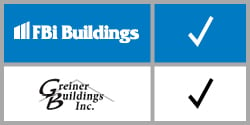
Wood
FBi Buildings
The type of wood that FBi uses is dependent on the building design.
For example, if you’re interested in a cold storage building with large clear-span trusses, then FBi will use Machine Stress-Rated (MSR) lumber. Each piece of MSR lumber is tested for stiffness and strength before installation.
Furthermore, FBi uses #1 Southern Yellow Pine (SYP) lumber for post frame projects that require smaller trusses.
Greiner Buildings
Greiner’s wood selection process is similar to FBi’s. Every Greiner post frame building features Rigidply Rafters’ Glu-Lam posts (made out of #1 SYP) and MSR lumber.
Who has the best wood?
This category results in a tie. Both construction companies use #1 SYP and MSR lumber. These wood choices are touted for their strength, durability, and adaptability.

Screws
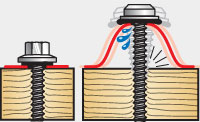 FBi Buildings
FBi Buildings
FBi uses a stainless steel capped, self-sealing screw. The screw fasteners encapsulate the sealing washer to protect it from the elements and improve aesthetics.
The washer maintains its seal and is more reliable than commonly used neoprene; thus, offering superior heat, cold, weather, and ozone resistance.
Greiner Buildings
Greiner uses a zinc-coated hex head screw. Unfortunately, this standard screw doesn’t include an umbrella, which protects the washer from deterioration.
Who has the best screws?
FBi is the better choice because all of their screws are stainless steel. Each screw head forms an “umbrella.” Without this extra defense layer, your pole barn is more susceptible to leaks and rust.

Trusses
FBi Buildings
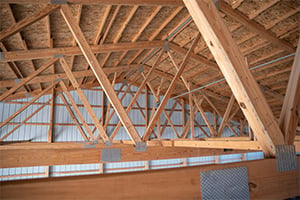
FBi’s trusses are manufactured by their in-house truss plant and engineered specifically for your pole barn.
Their truss plant is regularly certified by a third-party inspection service (e.g., Truss Plant Institute) to ensure the quality fabrication of all trusses.
The lumber used to build the trusses are joined with heavy-duty steel plates.
FBi’s trusses are interlocked – not just attached – to the laminated columns with structural screws. It provides the same strength as bolts, but for less money.
Moreover, FBi is the only post frame builder to screw roof purlins onto the trusses. Testing has proved that screws provide greater uplift resistance than nails.
Typically, purlins are spaced no more than 24’’ on center. The spacing and orientation depend on how far apart the trusses are spaced.
Greiner Buildings
Greiner’s trusses are manufactured by a local business with a “solid reputation in the post frame industry.”
This business uses higher standards (i.e., lumber grade and strength of gusset plates) required by local codes. As a result, their trusses can withstand heavier snow and wind loads.
Who has the best trusses?
FBi wins this category because of their in-house truss plant and quality control. FBi trusses are gently moved and handled fewer times, resulting in greater structural integrity.
Not to mention, their screwed-on purlins are a game-changer in the post frame industry. This fastener is less likely to be uplifted by forces, reducing the chances of rolled purlins and roof failure.

Paint
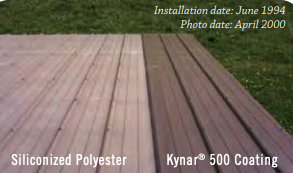 FBi Buildings
FBi Buildings
FBi’s roof and wall panels are finished with the Kynar 500 paint system.
This type of paint isn’t wet-dropped or sprayed-on, but baked-on for excellent resistance to fading, chalking, or corrosion. Their panels are known to maintain their vibrant color for 40+ years.
Do you need help picking a color scheme? Check out these tips for selecting the perfect pole barn color combination.
Greiner Buildings
Greiner’s steel panels are also painted with Kynar 500.
This coating material reduces urban energy, which is trapped solar energy that radiates back into the atmosphere. It can cause loss of vegetation and higher temperatures during the summer months.
The final result is a durable structure that withstands abrasion, ultraviolet radiation, extreme weather, chemicals, and solvents.
Who has the best paint?
This category results in a tie between FBi and Greiner as they both finish their steel panels with the Kynar 500 paint system.

Columns
FBi Buildings
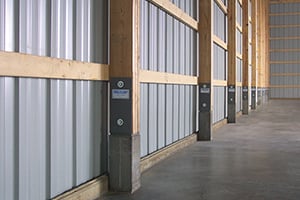
There are two types of ground contact when pricing your pole barn columns: Laminated Posts and Perma-Columns.
Similar to their trusses, FBi creates their laminated posts in-house. These columns have greater longevity than solid posts. Each layer of lumber is completely permeated with wood preservative and kiln-dried. It prevents rot and termite damage.
But not all column treatments are equal. FBi uses columns that are treated with 0.80 lb./cu. ft. of Chromated Copper Arsenate (CCA) wood preservative. That’s 33% more than industry standards, which you’ll find at hardware stores and lumber yards.
Alternatively, you can opt for Perma-Columns, which are precast concrete columns sized to fit any laminated or solid post.
This solution is guaranteed to withstand insect damage, decay, and rotting. No wood goes into the ground.
Using 10,000 PSI precast concrete, Perma-Columns are 3x stronger than standard concrete. Then, the columns are reinforced with 60,000 PSI rebar welded to a ¼’’ steel bracket.
Furthermore, Perma-Columns include microfibers to add shock resistance and durability. Microsilica enhances compressive strength and erosion resistance.
The corrosion inhibitor protects the rebar reinforcement and brackets from rusting. A final admixture is added for freeze and thaw protection.
Greiner Buildings
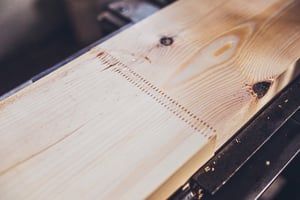 Greiner uses Glu-Lam posts made out of #1 SYP lumber. The columns are finger-jointed and won’t separate like its adhesive or nailed counterparts.
Greiner uses Glu-Lam posts made out of #1 SYP lumber. The columns are finger-jointed and won’t separate like its adhesive or nailed counterparts.
Standard Glu-Lam posts are treated with 0.60 lb./cu. ft. CCA and kiln-dried before lamination. Again, these treatments minimize decay and warping, respectively.
Additionally, Greiner offers Post Saver Sleeves with Notch Design. This thermoplastic barrier protects columns from insect and moisture damage.
The laminated posts are double layer wrapped in Bitumen and Polyethylene with a factory applied heat seal.
Bitumen is a wood coating that’s been used for 1,200+ years. Polyethylene is a waterproof membrane that’s been used for 50+ years.
Each column has uplift restraint notches on end. This system, when used with concrete, resists post-withdrawal caused by high winds.
Post Saver Sleeves with Notch Design are non-toxic and environmentally-friendly.
Who has the best columns?
While both construction companies use laminated posts, FBi’s Perma-Columns is a more sustainable option than Greiner’s Post Saver Sleeve with Notch Design.
The Post Saver Notch Design’s uplift capacity doesn’t compare to the Perma-Column’s steel anchor. FBi’s concrete column is much heavier, further resisting uplift loads. In fact, Perma-Columns add 15% to 30% more deadweight (depending on the building size).
The 10,000 PSI concrete and steel reinforcements have a greater capacity than wood in terms of resisting bending forces at ground level. This area happens to be one of the highest wind pressure points within a post frame building. Added stress on a standard post causes fatigue, affecting building longevity.
In freezing weather, Bitumen becomes brittle and will most likely crack. The black material is an active ingredient in asphalt. Paved roads tend to crumble during the winter freeze and thaw cycle.
This scenario can be applied to Post Saver Sleeves. Their decay zone is the same as the frost zone in Midwestern winters.
Lastly, smooth concrete is more aesthetically pleasing than tarred columns. It blends in well with a concrete or gravel floor. Whereas, some customers may view Post Saver Sleeves as an eyesore.

Doors
FBi Buildings
Sliding Doors
 FBi’s EasyMotion sliding door was introduced to the market in 2010. One of the perks included with this door option is the StepSaver Latch, which will save you time and energy.
FBi’s EasyMotion sliding door was introduced to the market in 2010. One of the perks included with this door option is the StepSaver Latch, which will save you time and energy.
No more running around to the walk-in door to disengage cam latches and snugger chains. You can get inside your building in less time. Just turn the key and grab the handle. It’s that simple!
The EasyMotion door features the Posi-Guide Track. It’s an exclusive weatherproof system that ensures your sliding door opens and closes smoothly all year round.
The guide doesn’t collect rain, ice, snow, or debris (i.e., birds’ nest and leaves). A unique low-friction polymer roller is protected behind and underneath the track. This interlocking system keeps the door snug to the building.
FBi offers the following center guide options for your sliding door:
- Wood center door stub
- Concrete center door stub (wet or dry)
- Concrete apron approach (wet or dry)
Overhead Doors
Overhead doors aren’t a standard feature with FBi pole barns. If you want to install an overhead door, FBi will work directly with their preferred vendors to get the style and size needed.
FBi’s engineers will carefully evaluate the entire building system and specify the necessary foundation, column, and header sizes needed to carry out the anticipated loads for each door.
Greiner Buildings
Sliding Doors
Greiner’s sliding doors use a metal roller and track system. They utilize a unique powder-coated framing system. Often, Greiner uses steel girts for heavy-duty doors that can slide straight with less friction.
Sliding doors can be single or split units. They’ve placed doors up to 40’ wide and 20’ tall.
Overhead Doors
Greiner installs insulated or non-insulated overhead doors for commercial businesses and residential dwellings. They offer a wide variety of colors, features, and sizes.
The maximum door width is approximately 32’ (depending on the overhead model). They require at least 2’ headroom to operate, which could be considered a drawback.
For farm shops, you can opt to install a hydraulic door. Greiner uses the same insulation in the door as your pole barn interior – no R-value loss! A tight seal lowers heat conduction. No additional headroom is needed. Widths up to 60’ can be installed.
If you like the idea of hydraulics, but you’re on a budget, Greiner can put in a bi-fold door.
Who has the best doors?
For sliding doors, FBi separates themselves apart from Greiner with their Posi-Guide Track.
Again, this system sits off the ground, eliminating door jambs caused by debris. The door track is rounded and self-cleaning (no oil needed). It’ll operate smoothly year after year.
Conversely, Greiner uses standard sliding door metal rollers. This component can rust or become weak. Their door track is exposed, which can collect debris and cause damage. As a result, you may run into issues with opening and closing your sliding door.
If you prefer to use overhead doors, both companies can find the style and size needed. Greiner gets a nod for performing their own installation.

Windows
FBi Buildings
![]()
 Believe it or not, there are many decisions to make when choosing windows for your pole barn. The windows offered by FBi are energy-efficient and available in popular styles, such as:
Believe it or not, there are many decisions to make when choosing windows for your pole barn. The windows offered by FBi are energy-efficient and available in popular styles, such as:
- Double-hung
- Single-slider
- Eyebrow
- Half-round
- Gothic
- Full circle
- Hexagon
- Quarter-round
Greiner Buildings
Greiner’s windows are designed specifically for pole barn use. They’re a one-piece unit installed over metal cladding. No J-channel needed.
Their windows are available in the following colors:
- Bronze
- Chocolate Brown
- Hickory Moss
- Polar White
- Custom (contact for more details)
Who has the best windows?
This category is a tie between FBi and Greiner as they both offer windows with their pole barns.
However, we do offer one piece of advice...don’t be afraid to shop around. Sometimes, you’ll find similar windows for a lower price at the local hardware store.

Who has the best overall materials?
As for pole barn materials, FBi comes out on top. They win three out of the eight categories; those being columns, screws, and trusses. Greiner ties FBi with their doors, paint, steel, windows, and wood.
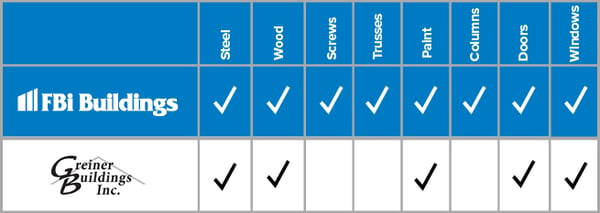
4) Delivery
FBi Buildings

On the first day of construction, your building materials will be delivered on-site. FBi doesn’t prefer to deliver materials beforehand and have them sit out in the elements until construction crews show up.
The building size will determine the type of equipment needed. Usually, FBi brings the following machinery to a job-site:
- A semi for material and delivery
- Gradall telehandler
- Crew truck and trailer
- Skid steer (if applicable)
- Crane (if applicable)
Company-employed drivers deliver materials straight from their own lumber yard.
Greiner Buildings
Similar to FBi, Greiner delivers their building materials to the job-site.
Who has the best delivery?
This category comes out to a tie as both companies will deliver your building components to the construction site.

5) Construction
FBi Buildings

The quality of the construction crew is a major factor in building your pole barn. Experienced men make fewer mistakes, giving you a higher quality building.
FBi Buildings crews are employees of FBi Buildings and are specifically trained in the safe construction of pole barns. FBi buildings strive to employ local individuals for crews across their expanding territory. This allows their 45+ crews to serve an area they are familiar with.
FBi Building's commitment is to provide you with excellent service from start to finish! We have a Crew Management team of construction veterans who oversee and support the foremen and his crew. In fact, our average tenure is over 17 years between our foremen and our crew management team!
In fact, FBi’s safety program has won the NFBA’s Gold and Platinum Level Achievement, as well as the Gail Miller Distinguished Safety Award. They’ve also won multiple NFBA Crew Foreman of the Year awards.
Greiner Buildings
Similar to FBi, Greiner’s construction crews are company-employed. They hire experienced workers and continually support them through training seminars on industry standards.
Their safety program has won the NFBA’s Gold and Platinum Level Achievement Award for “improving job-site safety through the development, implementation, and enforcement of a safety program.”
Who has the best construction?
Both post frame companies invest in their own construction crews, but the advantage goes to FBi.
They have tenure experience between their field workers and Crew Management teams. Their resources, coupled with direct accountability, is the best way to ensure quality performance.

6) Warranty
FBi Buildings
 A pole barn warranty is a written promise to stand behind a certain product or service. All warranties are limited, and there isn’t a standard one in the post frame industry. With that being said, you don’t want to skim through them.
A pole barn warranty is a written promise to stand behind a certain product or service. All warranties are limited, and there isn’t a standard one in the post frame industry. With that being said, you don’t want to skim through them.
The following components are covered under FBi’s warranty:
- Columns (Lifetime)
- Roof Structure (20 years)
- Red Rust (15 years)
- Paint (40 years)
- Gloss Loss (5 years)
- Roof Leaks (5 years)
- Sliding Doors (Lifetime)
Greiner Buildings
After researching Greiner’s website, the only listed warranties cover paint (40 years) and craftsmanship (lifetime). For more information, you’ll need to call or email their office.
Who has the best warranty?
FBi wins this category for having a more comprehensive list of warrantied features made available to the public.

7) Cost
FBi Buildings
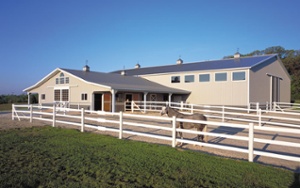 FBi is well aware that they aren’t the cheapest post frame builder in the industry, but they’re not the most expensive.
FBi is well aware that they aren’t the cheapest post frame builder in the industry, but they’re not the most expensive.
A standard pole barn shell can cost anywhere from $20 to $60 per square foot. Now, you’re probably asking yourself, “Why is there such a big difference in price per square foot?” Here’s why…
The following factors will determine if your pole barn is leaning towards the low/high side of the cost spectrum:
- Total square feet
- Type of features (e.g., overhangs, windows, walk-in doors, steel liner packages, etc.)
- Current nature of the commodities market (e.g., the price of lumber and steel)
For example, adding a porch, cupolas, and numerous doors will push you closer to the $60 per square foot. If you want a basic 30’ x 40’ without the bells and whistles, you’ll pay closer to the $20 per square foot.
Greiner Buildings
Greiner prides themselves on fast and free estimates. They calculate pole barn cost on location, square footage, and finishing features.
Who has the best cost?
Typically, Greiner Buildings is cheaper than FBi in terms of raw cost. Again, multiple factors go into pricing a pole barn. However, if you’re interested in turn-key construction, Greiner may be the better (albeit more expensive) option.

Who’s Best for Your Post Frame Building Project?
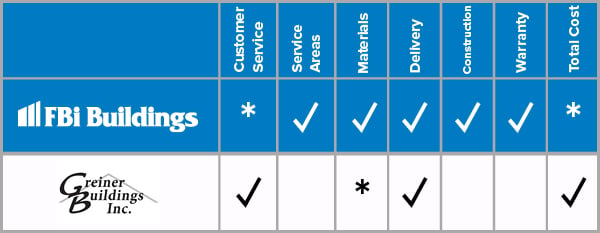
Note: The star denotes personal preference based on the buyer. Please reference each section for specifics.
Every post frame builder has their advantages and disadvantages, and the final decision is solely up to you and your specific needs.
- Greiner Buildings is the way to go if you’re looking for a one-stop-shop builder. Turn-key construction is important to those who don’t want the hassle of managing subcontractors.
- FBi Buildings is the right choice if you’re looking to make a long-lasting investment with a more personalized sales experience.
If you’re still unsure about what to do, we recommend checking out these additional resources:
- FBi Buildings vs Blunier Builders: Who’s Best for Your Project?
- FBi Buildings vs Cleary: Who’s Best for Your Project?
- FBi Buildings vs Lester: Who’s Best for Your Project?
- FBi Buildings vs Menards: Who’s Best for Your Project?
- FBi Buildings vs Morton: Who’s Best for Your Project?
- FBi Buildings vs Wick: Who’s Best for Your Project?
- 7 Questions to Ask Your Pole Barn Builder
- Ultimate Guide to Pole Barn Costs
- Pole Building Prices: 6 Considerations for Comparing
- What is Site Preparation? 7 Tips to Get You Started
We’d be happy to work with you on your pole barn project if you’re located in Indiana, Illinois, Iowa, Michigan, Missouri, or Ohio.
Do you have more questions that are not covered in this article? If you need help designing or planning, please contact FBi Buildings at 800.552.2981 or click here to email us. If you are ready to get a price, click here to request a quote, and a member of our Customer Engagement team will help you determine the next steps of your project.



